NURS20160 - Assessment 1: Evidence-Based Practice in Pandemic Nursing
VerifiedAdded on 2022/08/21
|8
|3308
|15
Homework Assignment
AI Summary
This homework assignment, completed by a nursing student, focuses on the topic of nursing care during a pandemic. The assignment begins by creating a PEO question related to the willingness of nursing staff to continue their duties during an infectious disease outbreak. It then details the search strategy, including database selection (Google Scholar and PubMed), search terms, and filters used to identify relevant research articles. The student analyzes five articles, summarizing their aims, methods, results, and limitations, and assessing their relevance to the PEO question. The analysis explores the willingness of nurses to provide care during pandemics, the influence of resources, and the application of findings to the Australian healthcare context. The assignment demonstrates the student's ability to conduct a literature review, synthesize information, and evaluate research evidence related to evidence-based nursing practice and clinical leadership.
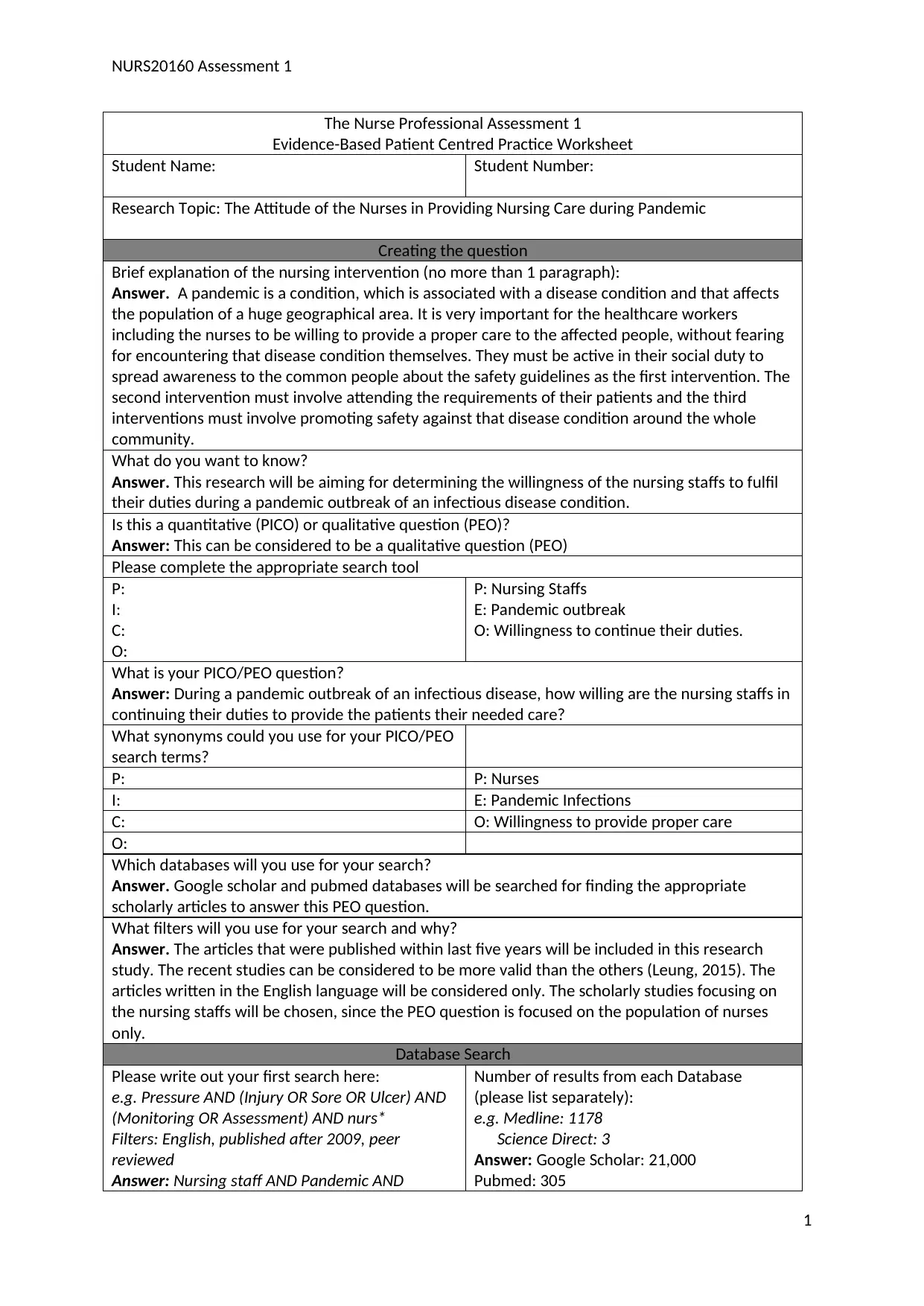
NURS20160 Assessment 1
The Nurse Professional Assessment 1
Evidence-Based Patient Centred Practice Worksheet
Student Name: Student Number:
Research Topic: The Attitude of the Nurses in Providing Nursing Care during Pandemic
Creating the question
Brief explanation of the nursing intervention (no more than 1 paragraph):
Answer. A pandemic is a condition, which is associated with a disease condition and that affects
the population of a huge geographical area. It is very important for the healthcare workers
including the nurses to be willing to provide a proper care to the affected people, without fearing
for encountering that disease condition themselves. They must be active in their social duty to
spread awareness to the common people about the safety guidelines as the first intervention. The
second intervention must involve attending the requirements of their patients and the third
interventions must involve promoting safety against that disease condition around the whole
community.
What do you want to know?
Answer. This research will be aiming for determining the willingness of the nursing staffs to fulfil
their duties during a pandemic outbreak of an infectious disease condition.
Is this a quantitative (PICO) or qualitative question (PEO)?
Answer: This can be considered to be a qualitative question (PEO)
Please complete the appropriate search tool
P:
I:
C:
O:
P: Nursing Staffs
E: Pandemic outbreak
O: Willingness to continue their duties.
What is your PICO/PEO question?
Answer: During a pandemic outbreak of an infectious disease, how willing are the nursing staffs in
continuing their duties to provide the patients their needed care?
What synonyms could you use for your PICO/PEO
search terms?
P: P: Nurses
I: E: Pandemic Infections
C: O: Willingness to provide proper care
O:
Which databases will you use for your search?
Answer. Google scholar and pubmed databases will be searched for finding the appropriate
scholarly articles to answer this PEO question.
What filters will you use for your search and why?
Answer. The articles that were published within last five years will be included in this research
study. The recent studies can be considered to be more valid than the others (Leung, 2015). The
articles written in the English language will be considered only. The scholarly studies focusing on
the nursing staffs will be chosen, since the PEO question is focused on the population of nurses
only.
Database Search
Please write out your first search here:
e.g. Pressure AND (Injury OR Sore OR Ulcer) AND
(Monitoring OR Assessment) AND nurs*
Filters: English, published after 2009, peer
reviewed
Answer: Nursing staff AND Pandemic AND
Number of results from each Database
(please list separately):
e.g. Medline: 1178
Science Direct: 3
Answer: Google Scholar: 21,000
Pubmed: 305
1
The Nurse Professional Assessment 1
Evidence-Based Patient Centred Practice Worksheet
Student Name: Student Number:
Research Topic: The Attitude of the Nurses in Providing Nursing Care during Pandemic
Creating the question
Brief explanation of the nursing intervention (no more than 1 paragraph):
Answer. A pandemic is a condition, which is associated with a disease condition and that affects
the population of a huge geographical area. It is very important for the healthcare workers
including the nurses to be willing to provide a proper care to the affected people, without fearing
for encountering that disease condition themselves. They must be active in their social duty to
spread awareness to the common people about the safety guidelines as the first intervention. The
second intervention must involve attending the requirements of their patients and the third
interventions must involve promoting safety against that disease condition around the whole
community.
What do you want to know?
Answer. This research will be aiming for determining the willingness of the nursing staffs to fulfil
their duties during a pandemic outbreak of an infectious disease condition.
Is this a quantitative (PICO) or qualitative question (PEO)?
Answer: This can be considered to be a qualitative question (PEO)
Please complete the appropriate search tool
P:
I:
C:
O:
P: Nursing Staffs
E: Pandemic outbreak
O: Willingness to continue their duties.
What is your PICO/PEO question?
Answer: During a pandemic outbreak of an infectious disease, how willing are the nursing staffs in
continuing their duties to provide the patients their needed care?
What synonyms could you use for your PICO/PEO
search terms?
P: P: Nurses
I: E: Pandemic Infections
C: O: Willingness to provide proper care
O:
Which databases will you use for your search?
Answer. Google scholar and pubmed databases will be searched for finding the appropriate
scholarly articles to answer this PEO question.
What filters will you use for your search and why?
Answer. The articles that were published within last five years will be included in this research
study. The recent studies can be considered to be more valid than the others (Leung, 2015). The
articles written in the English language will be considered only. The scholarly studies focusing on
the nursing staffs will be chosen, since the PEO question is focused on the population of nurses
only.
Database Search
Please write out your first search here:
e.g. Pressure AND (Injury OR Sore OR Ulcer) AND
(Monitoring OR Assessment) AND nurs*
Filters: English, published after 2009, peer
reviewed
Answer: Nursing staff AND Pandemic AND
Number of results from each Database
(please list separately):
e.g. Medline: 1178
Science Direct: 3
Answer: Google Scholar: 21,000
Pubmed: 305
1
Paraphrase This Document
Need a fresh take? Get an instant paraphrase of this document with our AI Paraphraser
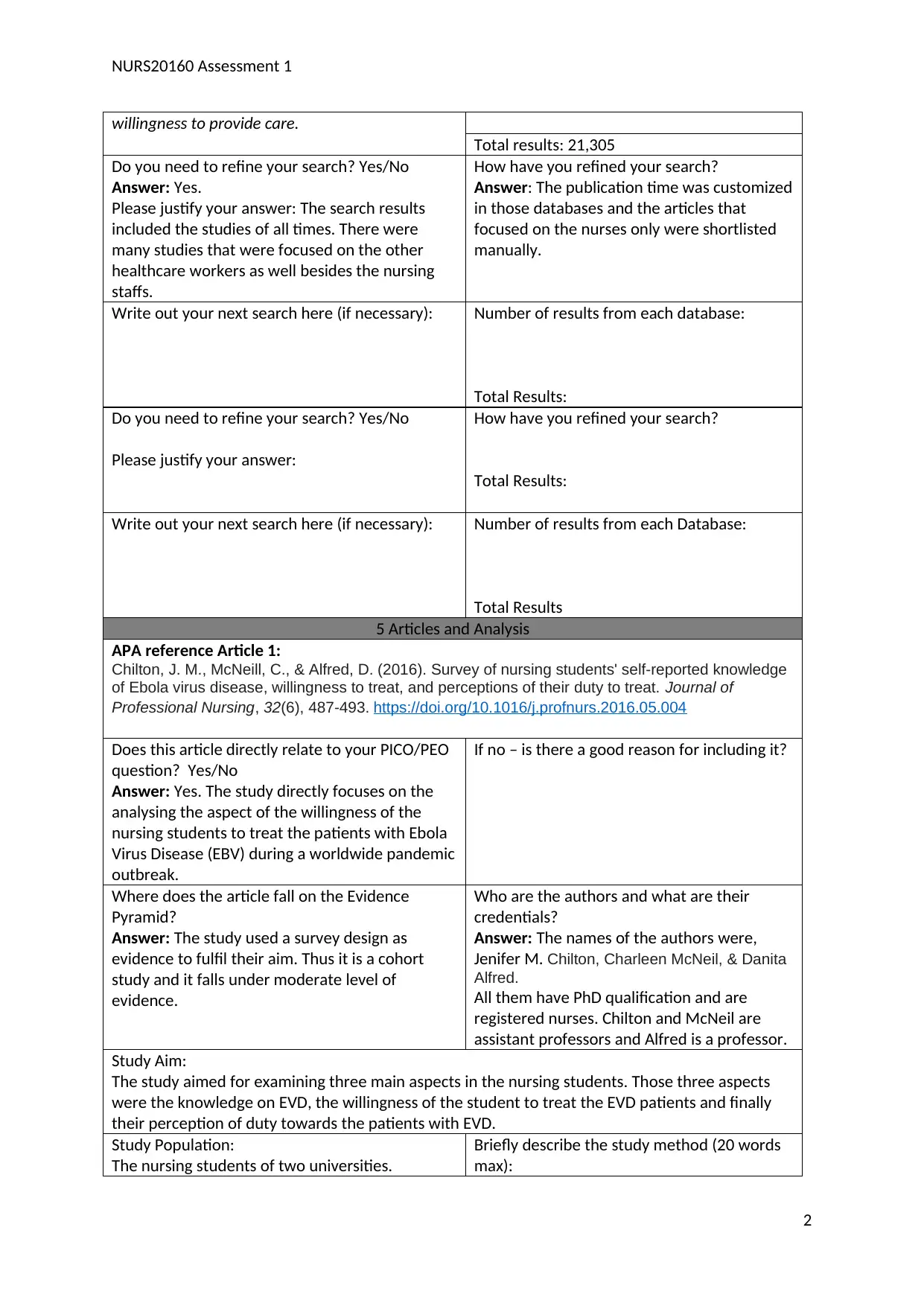
NURS20160 Assessment 1
willingness to provide care.
Total results: 21,305
Do you need to refine your search? Yes/No
Answer: Yes.
Please justify your answer: The search results
included the studies of all times. There were
many studies that were focused on the other
healthcare workers as well besides the nursing
staffs.
How have you refined your search?
Answer: The publication time was customized
in those databases and the articles that
focused on the nurses only were shortlisted
manually.
Write out your next search here (if necessary): Number of results from each database:
Total Results:
Do you need to refine your search? Yes/No
Please justify your answer:
How have you refined your search?
Total Results:
Write out your next search here (if necessary): Number of results from each Database:
Total Results
5 Articles and Analysis
APA reference Article 1:
Chilton, J. M., McNeill, C., & Alfred, D. (2016). Survey of nursing students' self-reported knowledge
of Ebola virus disease, willingness to treat, and perceptions of their duty to treat. Journal of
Professional Nursing, 32(6), 487-493. https://doi.org/10.1016/j.profnurs.2016.05.004
Does this article directly relate to your PICO/PEO
question? Yes/No
Answer: Yes. The study directly focuses on the
analysing the aspect of the willingness of the
nursing students to treat the patients with Ebola
Virus Disease (EBV) during a worldwide pandemic
outbreak.
If no – is there a good reason for including it?
Where does the article fall on the Evidence
Pyramid?
Answer: The study used a survey design as
evidence to fulfil their aim. Thus it is a cohort
study and it falls under moderate level of
evidence.
Who are the authors and what are their
credentials?
Answer: The names of the authors were,
Jenifer M. Chilton, Charleen McNeil, & Danita
Alfred.
All them have PhD qualification and are
registered nurses. Chilton and McNeil are
assistant professors and Alfred is a professor.
Study Aim:
The study aimed for examining three main aspects in the nursing students. Those three aspects
were the knowledge on EVD, the willingness of the student to treat the EVD patients and finally
their perception of duty towards the patients with EVD.
Study Population:
The nursing students of two universities.
Briefly describe the study method (20 words
max):
2
willingness to provide care.
Total results: 21,305
Do you need to refine your search? Yes/No
Answer: Yes.
Please justify your answer: The search results
included the studies of all times. There were
many studies that were focused on the other
healthcare workers as well besides the nursing
staffs.
How have you refined your search?
Answer: The publication time was customized
in those databases and the articles that
focused on the nurses only were shortlisted
manually.
Write out your next search here (if necessary): Number of results from each database:
Total Results:
Do you need to refine your search? Yes/No
Please justify your answer:
How have you refined your search?
Total Results:
Write out your next search here (if necessary): Number of results from each Database:
Total Results
5 Articles and Analysis
APA reference Article 1:
Chilton, J. M., McNeill, C., & Alfred, D. (2016). Survey of nursing students' self-reported knowledge
of Ebola virus disease, willingness to treat, and perceptions of their duty to treat. Journal of
Professional Nursing, 32(6), 487-493. https://doi.org/10.1016/j.profnurs.2016.05.004
Does this article directly relate to your PICO/PEO
question? Yes/No
Answer: Yes. The study directly focuses on the
analysing the aspect of the willingness of the
nursing students to treat the patients with Ebola
Virus Disease (EBV) during a worldwide pandemic
outbreak.
If no – is there a good reason for including it?
Where does the article fall on the Evidence
Pyramid?
Answer: The study used a survey design as
evidence to fulfil their aim. Thus it is a cohort
study and it falls under moderate level of
evidence.
Who are the authors and what are their
credentials?
Answer: The names of the authors were,
Jenifer M. Chilton, Charleen McNeil, & Danita
Alfred.
All them have PhD qualification and are
registered nurses. Chilton and McNeil are
assistant professors and Alfred is a professor.
Study Aim:
The study aimed for examining three main aspects in the nursing students. Those three aspects
were the knowledge on EVD, the willingness of the student to treat the EVD patients and finally
their perception of duty towards the patients with EVD.
Study Population:
The nursing students of two universities.
Briefly describe the study method (20 words
max):
2
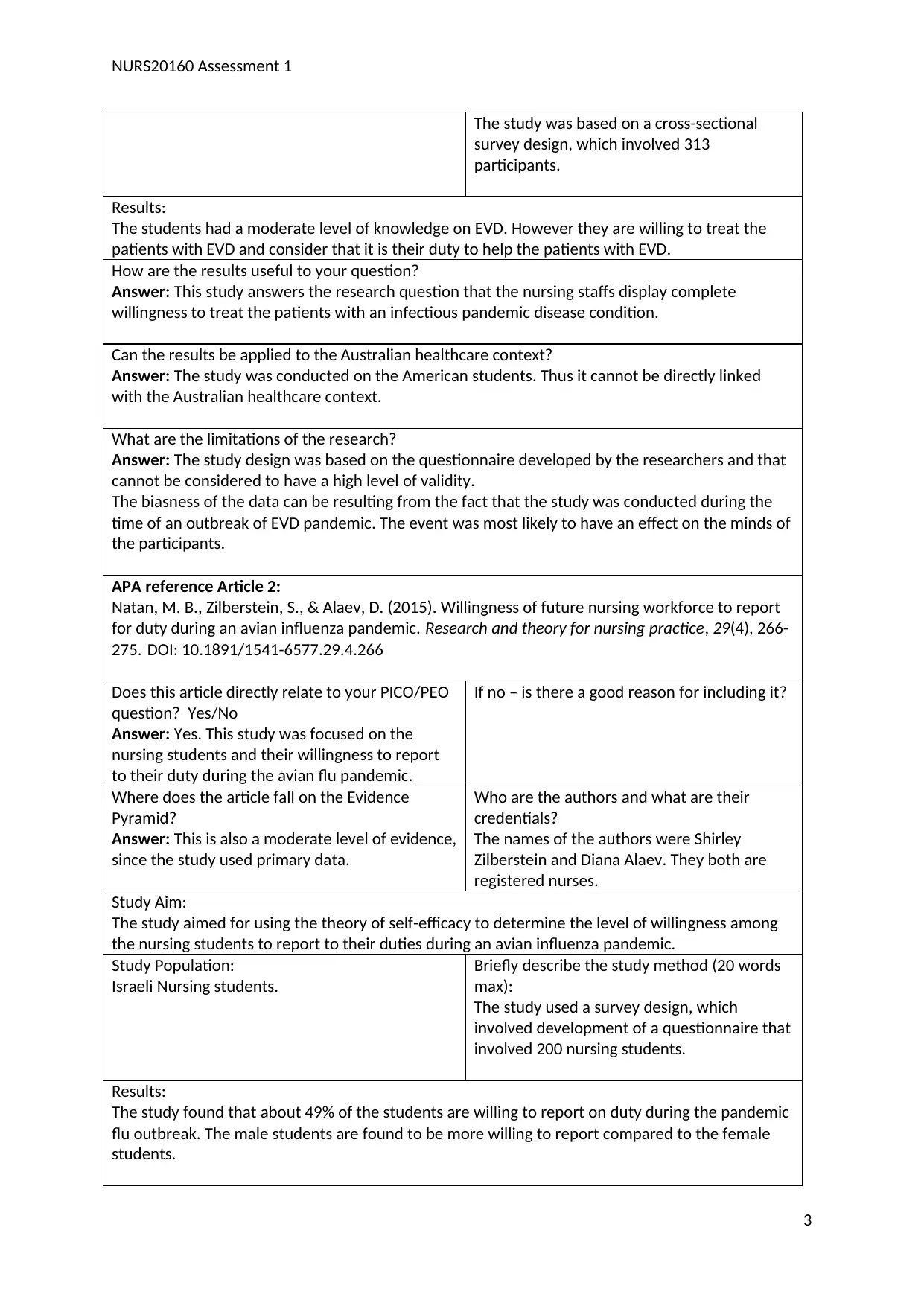
NURS20160 Assessment 1
The study was based on a cross-sectional
survey design, which involved 313
participants.
Results:
The students had a moderate level of knowledge on EVD. However they are willing to treat the
patients with EVD and consider that it is their duty to help the patients with EVD.
How are the results useful to your question?
Answer: This study answers the research question that the nursing staffs display complete
willingness to treat the patients with an infectious pandemic disease condition.
Can the results be applied to the Australian healthcare context?
Answer: The study was conducted on the American students. Thus it cannot be directly linked
with the Australian healthcare context.
What are the limitations of the research?
Answer: The study design was based on the questionnaire developed by the researchers and that
cannot be considered to have a high level of validity.
The biasness of the data can be resulting from the fact that the study was conducted during the
time of an outbreak of EVD pandemic. The event was most likely to have an effect on the minds of
the participants.
APA reference Article 2:
Natan, M. B., Zilberstein, S., & Alaev, D. (2015). Willingness of future nursing workforce to report
for duty during an avian influenza pandemic. Research and theory for nursing practice, 29(4), 266-
275. DOI: 10.1891/1541-6577.29.4.266
Does this article directly relate to your PICO/PEO
question? Yes/No
Answer: Yes. This study was focused on the
nursing students and their willingness to report
to their duty during the avian flu pandemic.
If no – is there a good reason for including it?
Where does the article fall on the Evidence
Pyramid?
Answer: This is also a moderate level of evidence,
since the study used primary data.
Who are the authors and what are their
credentials?
The names of the authors were Shirley
Zilberstein and Diana Alaev. They both are
registered nurses.
Study Aim:
The study aimed for using the theory of self-efficacy to determine the level of willingness among
the nursing students to report to their duties during an avian influenza pandemic.
Study Population:
Israeli Nursing students.
Briefly describe the study method (20 words
max):
The study used a survey design, which
involved development of a questionnaire that
involved 200 nursing students.
Results:
The study found that about 49% of the students are willing to report on duty during the pandemic
flu outbreak. The male students are found to be more willing to report compared to the female
students.
3
The study was based on a cross-sectional
survey design, which involved 313
participants.
Results:
The students had a moderate level of knowledge on EVD. However they are willing to treat the
patients with EVD and consider that it is their duty to help the patients with EVD.
How are the results useful to your question?
Answer: This study answers the research question that the nursing staffs display complete
willingness to treat the patients with an infectious pandemic disease condition.
Can the results be applied to the Australian healthcare context?
Answer: The study was conducted on the American students. Thus it cannot be directly linked
with the Australian healthcare context.
What are the limitations of the research?
Answer: The study design was based on the questionnaire developed by the researchers and that
cannot be considered to have a high level of validity.
The biasness of the data can be resulting from the fact that the study was conducted during the
time of an outbreak of EVD pandemic. The event was most likely to have an effect on the minds of
the participants.
APA reference Article 2:
Natan, M. B., Zilberstein, S., & Alaev, D. (2015). Willingness of future nursing workforce to report
for duty during an avian influenza pandemic. Research and theory for nursing practice, 29(4), 266-
275. DOI: 10.1891/1541-6577.29.4.266
Does this article directly relate to your PICO/PEO
question? Yes/No
Answer: Yes. This study was focused on the
nursing students and their willingness to report
to their duty during the avian flu pandemic.
If no – is there a good reason for including it?
Where does the article fall on the Evidence
Pyramid?
Answer: This is also a moderate level of evidence,
since the study used primary data.
Who are the authors and what are their
credentials?
The names of the authors were Shirley
Zilberstein and Diana Alaev. They both are
registered nurses.
Study Aim:
The study aimed for using the theory of self-efficacy to determine the level of willingness among
the nursing students to report to their duties during an avian influenza pandemic.
Study Population:
Israeli Nursing students.
Briefly describe the study method (20 words
max):
The study used a survey design, which
involved development of a questionnaire that
involved 200 nursing students.
Results:
The study found that about 49% of the students are willing to report on duty during the pandemic
flu outbreak. The male students are found to be more willing to report compared to the female
students.
3
⊘ This is a preview!⊘
Do you want full access?
Subscribe today to unlock all pages.

Trusted by 1+ million students worldwide
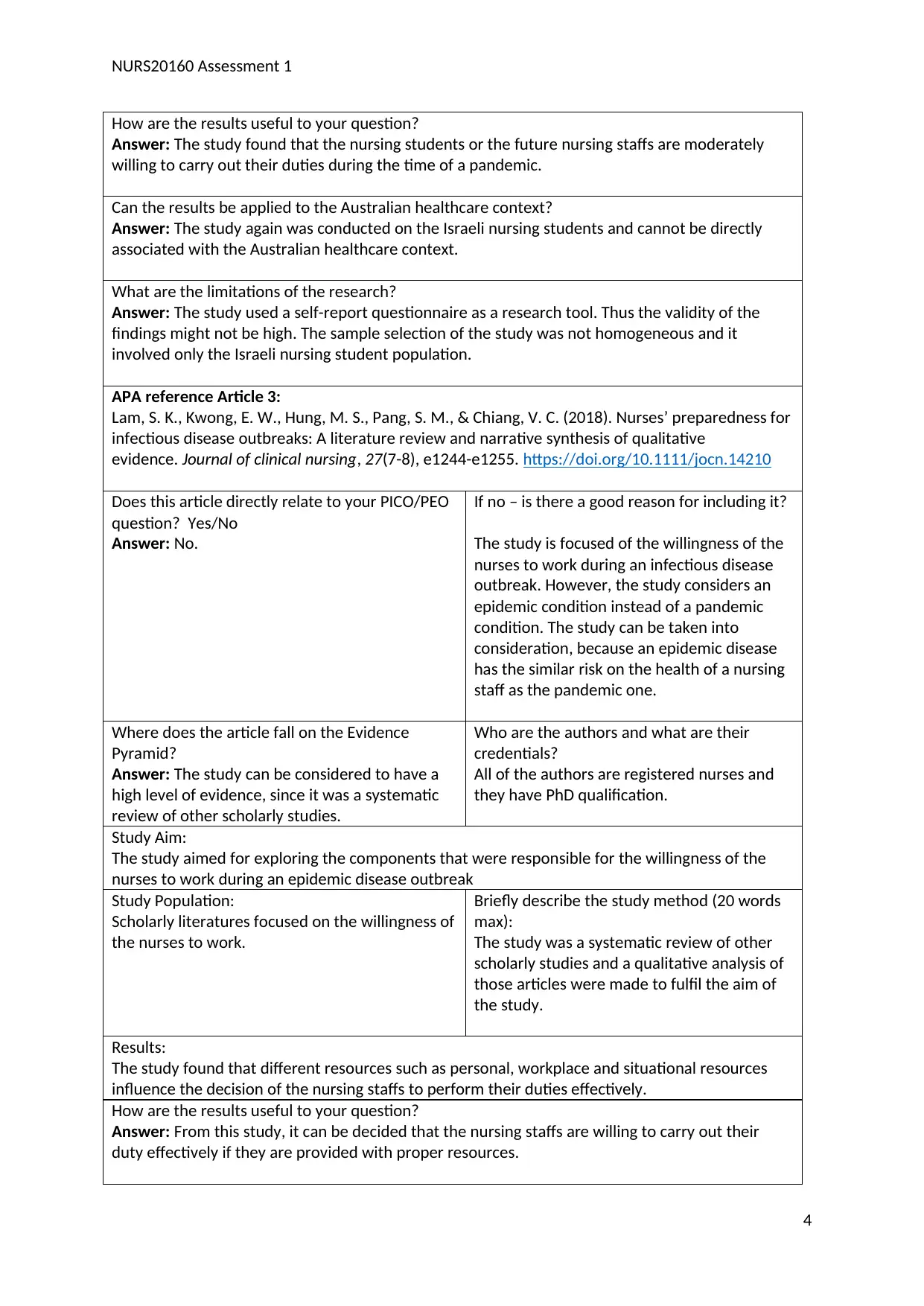
NURS20160 Assessment 1
How are the results useful to your question?
Answer: The study found that the nursing students or the future nursing staffs are moderately
willing to carry out their duties during the time of a pandemic.
Can the results be applied to the Australian healthcare context?
Answer: The study again was conducted on the Israeli nursing students and cannot be directly
associated with the Australian healthcare context.
What are the limitations of the research?
Answer: The study used a self-report questionnaire as a research tool. Thus the validity of the
findings might not be high. The sample selection of the study was not homogeneous and it
involved only the Israeli nursing student population.
APA reference Article 3:
Lam, S. K., Kwong, E. W., Hung, M. S., Pang, S. M., & Chiang, V. C. (2018). Nurses’ preparedness for
infectious disease outbreaks: A literature review and narrative synthesis of qualitative
evidence. Journal of clinical nursing, 27(7-8), e1244-e1255. https://doi.org/10.1111/jocn.14210
Does this article directly relate to your PICO/PEO
question? Yes/No
Answer: No.
If no – is there a good reason for including it?
The study is focused of the willingness of the
nurses to work during an infectious disease
outbreak. However, the study considers an
epidemic condition instead of a pandemic
condition. The study can be taken into
consideration, because an epidemic disease
has the similar risk on the health of a nursing
staff as the pandemic one.
Where does the article fall on the Evidence
Pyramid?
Answer: The study can be considered to have a
high level of evidence, since it was a systematic
review of other scholarly studies.
Who are the authors and what are their
credentials?
All of the authors are registered nurses and
they have PhD qualification.
Study Aim:
The study aimed for exploring the components that were responsible for the willingness of the
nurses to work during an epidemic disease outbreak
Study Population:
Scholarly literatures focused on the willingness of
the nurses to work.
Briefly describe the study method (20 words
max):
The study was a systematic review of other
scholarly studies and a qualitative analysis of
those articles were made to fulfil the aim of
the study.
Results:
The study found that different resources such as personal, workplace and situational resources
influence the decision of the nursing staffs to perform their duties effectively.
How are the results useful to your question?
Answer: From this study, it can be decided that the nursing staffs are willing to carry out their
duty effectively if they are provided with proper resources.
4
How are the results useful to your question?
Answer: The study found that the nursing students or the future nursing staffs are moderately
willing to carry out their duties during the time of a pandemic.
Can the results be applied to the Australian healthcare context?
Answer: The study again was conducted on the Israeli nursing students and cannot be directly
associated with the Australian healthcare context.
What are the limitations of the research?
Answer: The study used a self-report questionnaire as a research tool. Thus the validity of the
findings might not be high. The sample selection of the study was not homogeneous and it
involved only the Israeli nursing student population.
APA reference Article 3:
Lam, S. K., Kwong, E. W., Hung, M. S., Pang, S. M., & Chiang, V. C. (2018). Nurses’ preparedness for
infectious disease outbreaks: A literature review and narrative synthesis of qualitative
evidence. Journal of clinical nursing, 27(7-8), e1244-e1255. https://doi.org/10.1111/jocn.14210
Does this article directly relate to your PICO/PEO
question? Yes/No
Answer: No.
If no – is there a good reason for including it?
The study is focused of the willingness of the
nurses to work during an infectious disease
outbreak. However, the study considers an
epidemic condition instead of a pandemic
condition. The study can be taken into
consideration, because an epidemic disease
has the similar risk on the health of a nursing
staff as the pandemic one.
Where does the article fall on the Evidence
Pyramid?
Answer: The study can be considered to have a
high level of evidence, since it was a systematic
review of other scholarly studies.
Who are the authors and what are their
credentials?
All of the authors are registered nurses and
they have PhD qualification.
Study Aim:
The study aimed for exploring the components that were responsible for the willingness of the
nurses to work during an epidemic disease outbreak
Study Population:
Scholarly literatures focused on the willingness of
the nurses to work.
Briefly describe the study method (20 words
max):
The study was a systematic review of other
scholarly studies and a qualitative analysis of
those articles were made to fulfil the aim of
the study.
Results:
The study found that different resources such as personal, workplace and situational resources
influence the decision of the nursing staffs to perform their duties effectively.
How are the results useful to your question?
Answer: From this study, it can be decided that the nursing staffs are willing to carry out their
duty effectively if they are provided with proper resources.
4
Paraphrase This Document
Need a fresh take? Get an instant paraphrase of this document with our AI Paraphraser
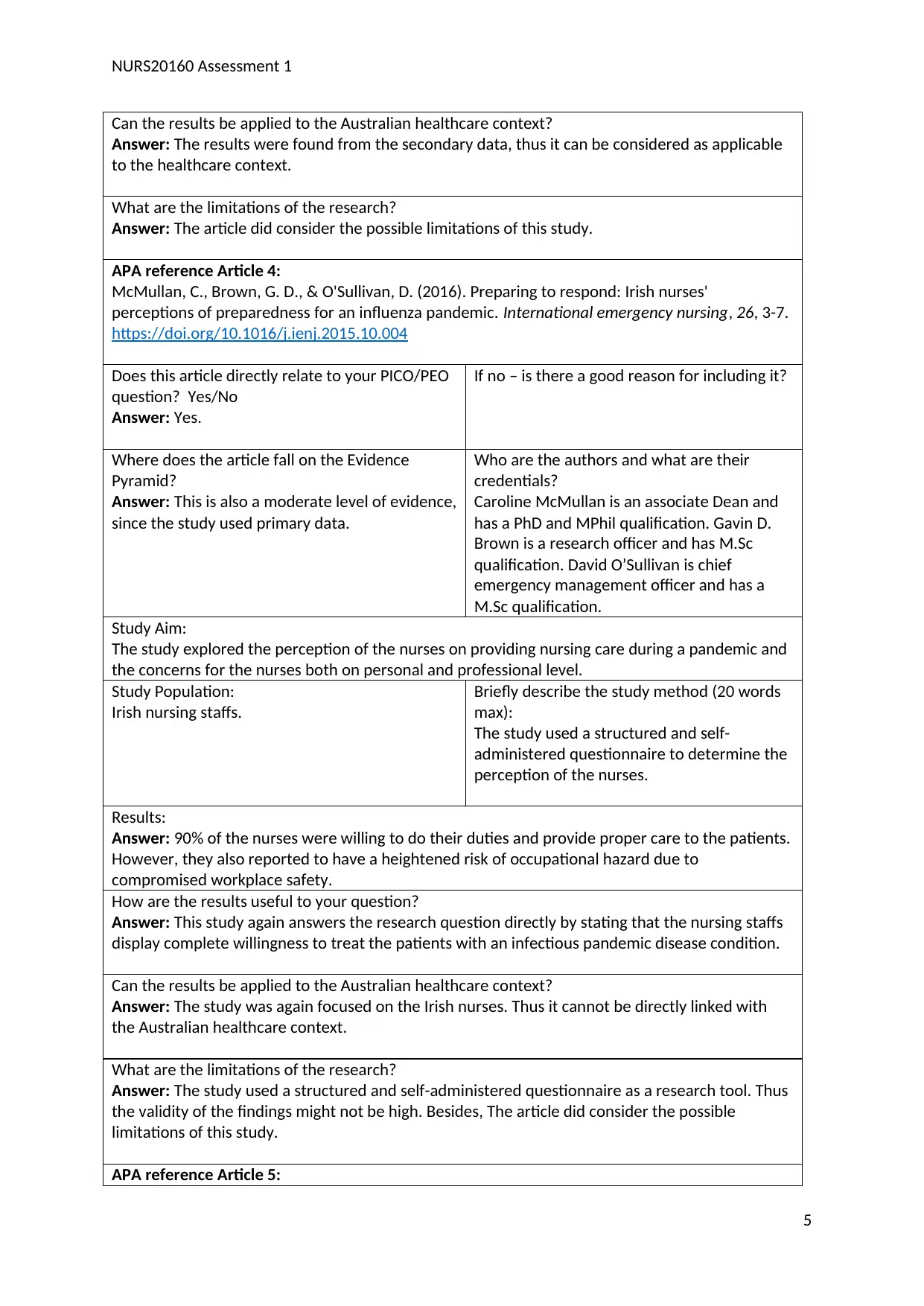
NURS20160 Assessment 1
Can the results be applied to the Australian healthcare context?
Answer: The results were found from the secondary data, thus it can be considered as applicable
to the healthcare context.
What are the limitations of the research?
Answer: The article did consider the possible limitations of this study.
APA reference Article 4:
McMullan, C., Brown, G. D., & O'Sullivan, D. (2016). Preparing to respond: Irish nurses'
perceptions of preparedness for an influenza pandemic. International emergency nursing, 26, 3-7.
https://doi.org/10.1016/j.ienj.2015.10.004
Does this article directly relate to your PICO/PEO
question? Yes/No
Answer: Yes.
If no – is there a good reason for including it?
Where does the article fall on the Evidence
Pyramid?
Answer: This is also a moderate level of evidence,
since the study used primary data.
Who are the authors and what are their
credentials?
Caroline McMullan is an associate Dean and
has a PhD and MPhil qualification. Gavin D.
Brown is a research officer and has M.Sc
qualification. David O’Sullivan is chief
emergency management officer and has a
M.Sc qualification.
Study Aim:
The study explored the perception of the nurses on providing nursing care during a pandemic and
the concerns for the nurses both on personal and professional level.
Study Population:
Irish nursing staffs.
Briefly describe the study method (20 words
max):
The study used a structured and self-
administered questionnaire to determine the
perception of the nurses.
Results:
Answer: 90% of the nurses were willing to do their duties and provide proper care to the patients.
However, they also reported to have a heightened risk of occupational hazard due to
compromised workplace safety.
How are the results useful to your question?
Answer: This study again answers the research question directly by stating that the nursing staffs
display complete willingness to treat the patients with an infectious pandemic disease condition.
Can the results be applied to the Australian healthcare context?
Answer: The study was again focused on the Irish nurses. Thus it cannot be directly linked with
the Australian healthcare context.
What are the limitations of the research?
Answer: The study used a structured and self-administered questionnaire as a research tool. Thus
the validity of the findings might not be high. Besides, The article did consider the possible
limitations of this study.
APA reference Article 5:
5
Can the results be applied to the Australian healthcare context?
Answer: The results were found from the secondary data, thus it can be considered as applicable
to the healthcare context.
What are the limitations of the research?
Answer: The article did consider the possible limitations of this study.
APA reference Article 4:
McMullan, C., Brown, G. D., & O'Sullivan, D. (2016). Preparing to respond: Irish nurses'
perceptions of preparedness for an influenza pandemic. International emergency nursing, 26, 3-7.
https://doi.org/10.1016/j.ienj.2015.10.004
Does this article directly relate to your PICO/PEO
question? Yes/No
Answer: Yes.
If no – is there a good reason for including it?
Where does the article fall on the Evidence
Pyramid?
Answer: This is also a moderate level of evidence,
since the study used primary data.
Who are the authors and what are their
credentials?
Caroline McMullan is an associate Dean and
has a PhD and MPhil qualification. Gavin D.
Brown is a research officer and has M.Sc
qualification. David O’Sullivan is chief
emergency management officer and has a
M.Sc qualification.
Study Aim:
The study explored the perception of the nurses on providing nursing care during a pandemic and
the concerns for the nurses both on personal and professional level.
Study Population:
Irish nursing staffs.
Briefly describe the study method (20 words
max):
The study used a structured and self-
administered questionnaire to determine the
perception of the nurses.
Results:
Answer: 90% of the nurses were willing to do their duties and provide proper care to the patients.
However, they also reported to have a heightened risk of occupational hazard due to
compromised workplace safety.
How are the results useful to your question?
Answer: This study again answers the research question directly by stating that the nursing staffs
display complete willingness to treat the patients with an infectious pandemic disease condition.
Can the results be applied to the Australian healthcare context?
Answer: The study was again focused on the Irish nurses. Thus it cannot be directly linked with
the Australian healthcare context.
What are the limitations of the research?
Answer: The study used a structured and self-administered questionnaire as a research tool. Thus
the validity of the findings might not be high. Besides, The article did consider the possible
limitations of this study.
APA reference Article 5:
5
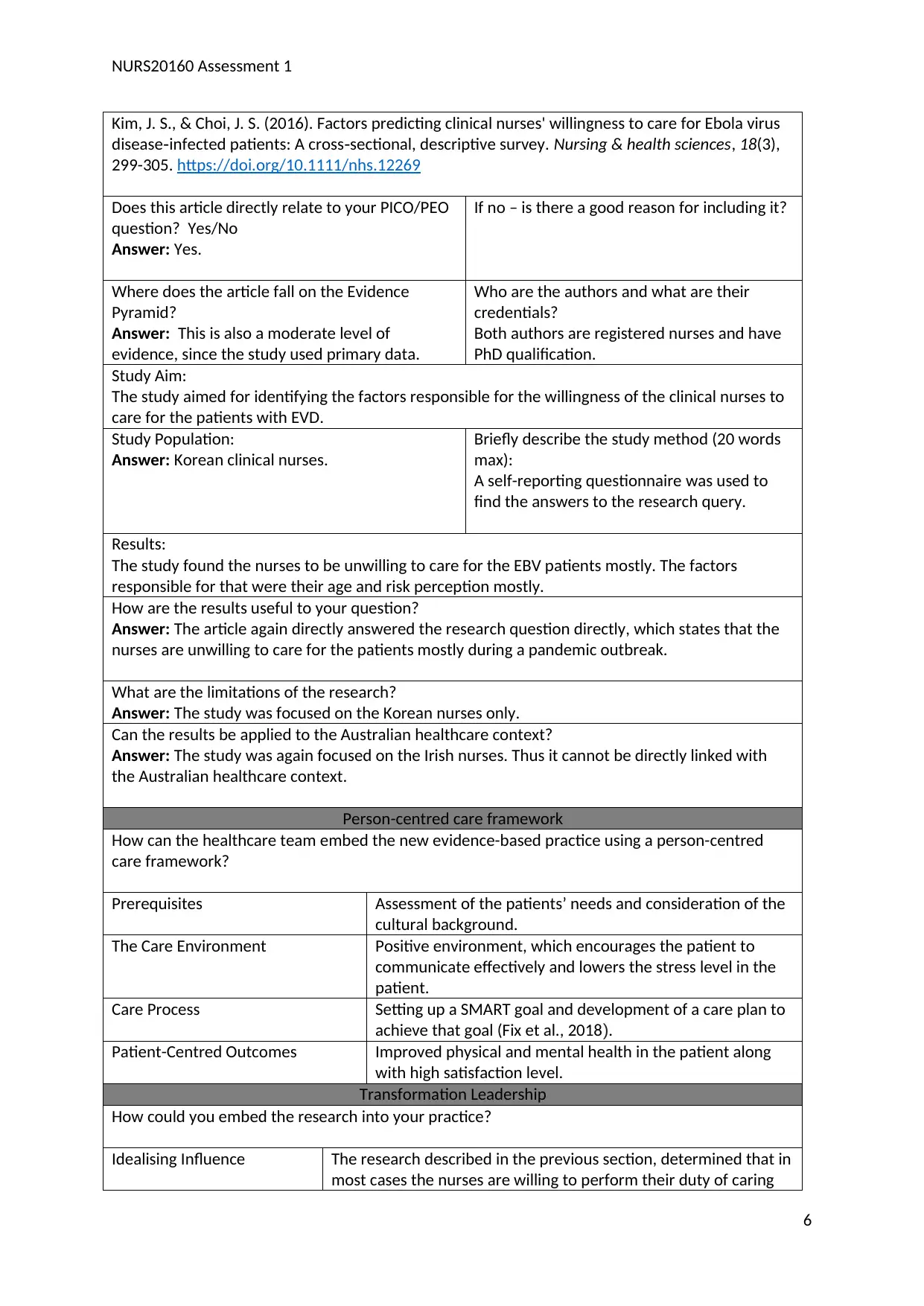
NURS20160 Assessment 1
Kim, J. S., & Choi, J. S. (2016). Factors predicting clinical nurses' willingness to care for Ebola virus
disease infected patients: A cross sectional, descriptive survey.‐ ‐ Nursing & health sciences, 18(3),
299-305. https://doi.org/10.1111/nhs.12269
Does this article directly relate to your PICO/PEO
question? Yes/No
Answer: Yes.
If no – is there a good reason for including it?
Where does the article fall on the Evidence
Pyramid?
Answer: This is also a moderate level of
evidence, since the study used primary data.
Who are the authors and what are their
credentials?
Both authors are registered nurses and have
PhD qualification.
Study Aim:
The study aimed for identifying the factors responsible for the willingness of the clinical nurses to
care for the patients with EVD.
Study Population:
Answer: Korean clinical nurses.
Briefly describe the study method (20 words
max):
A self-reporting questionnaire was used to
find the answers to the research query.
Results:
The study found the nurses to be unwilling to care for the EBV patients mostly. The factors
responsible for that were their age and risk perception mostly.
How are the results useful to your question?
Answer: The article again directly answered the research question directly, which states that the
nurses are unwilling to care for the patients mostly during a pandemic outbreak.
What are the limitations of the research?
Answer: The study was focused on the Korean nurses only.
Can the results be applied to the Australian healthcare context?
Answer: The study was again focused on the Irish nurses. Thus it cannot be directly linked with
the Australian healthcare context.
Person-centred care framework
How can the healthcare team embed the new evidence-based practice using a person-centred
care framework?
Prerequisites Assessment of the patients’ needs and consideration of the
cultural background.
The Care Environment Positive environment, which encourages the patient to
communicate effectively and lowers the stress level in the
patient.
Care Process Setting up a SMART goal and development of a care plan to
achieve that goal (Fix et al., 2018).
Patient-Centred Outcomes Improved physical and mental health in the patient along
with high satisfaction level.
Transformation Leadership
How could you embed the research into your practice?
Idealising Influence The research described in the previous section, determined that in
most cases the nurses are willing to perform their duty of caring
6
Kim, J. S., & Choi, J. S. (2016). Factors predicting clinical nurses' willingness to care for Ebola virus
disease infected patients: A cross sectional, descriptive survey.‐ ‐ Nursing & health sciences, 18(3),
299-305. https://doi.org/10.1111/nhs.12269
Does this article directly relate to your PICO/PEO
question? Yes/No
Answer: Yes.
If no – is there a good reason for including it?
Where does the article fall on the Evidence
Pyramid?
Answer: This is also a moderate level of
evidence, since the study used primary data.
Who are the authors and what are their
credentials?
Both authors are registered nurses and have
PhD qualification.
Study Aim:
The study aimed for identifying the factors responsible for the willingness of the clinical nurses to
care for the patients with EVD.
Study Population:
Answer: Korean clinical nurses.
Briefly describe the study method (20 words
max):
A self-reporting questionnaire was used to
find the answers to the research query.
Results:
The study found the nurses to be unwilling to care for the EBV patients mostly. The factors
responsible for that were their age and risk perception mostly.
How are the results useful to your question?
Answer: The article again directly answered the research question directly, which states that the
nurses are unwilling to care for the patients mostly during a pandemic outbreak.
What are the limitations of the research?
Answer: The study was focused on the Korean nurses only.
Can the results be applied to the Australian healthcare context?
Answer: The study was again focused on the Irish nurses. Thus it cannot be directly linked with
the Australian healthcare context.
Person-centred care framework
How can the healthcare team embed the new evidence-based practice using a person-centred
care framework?
Prerequisites Assessment of the patients’ needs and consideration of the
cultural background.
The Care Environment Positive environment, which encourages the patient to
communicate effectively and lowers the stress level in the
patient.
Care Process Setting up a SMART goal and development of a care plan to
achieve that goal (Fix et al., 2018).
Patient-Centred Outcomes Improved physical and mental health in the patient along
with high satisfaction level.
Transformation Leadership
How could you embed the research into your practice?
Idealising Influence The research described in the previous section, determined that in
most cases the nurses are willing to perform their duty of caring
6
⊘ This is a preview!⊘
Do you want full access?
Subscribe today to unlock all pages.

Trusted by 1+ million students worldwide
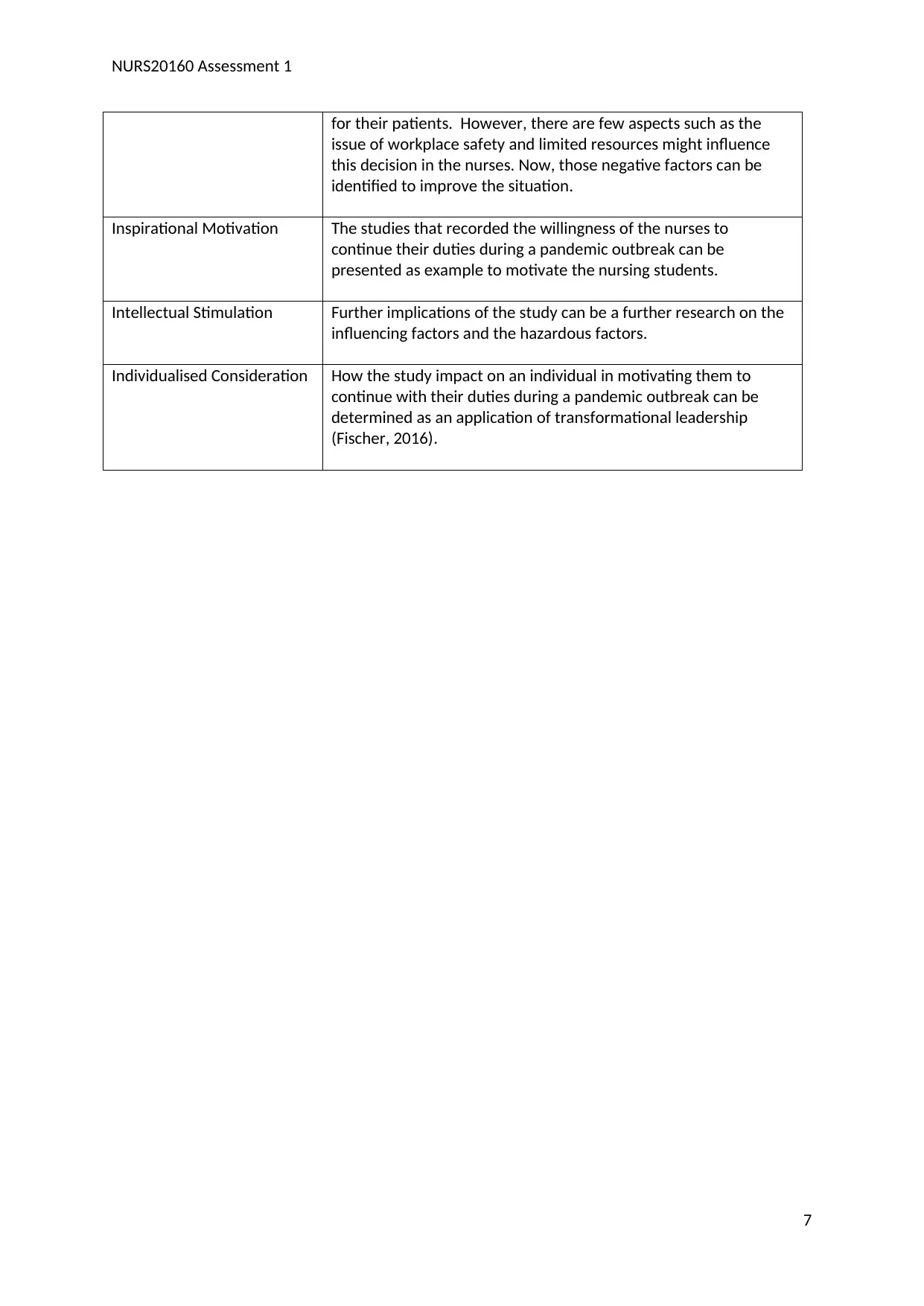
NURS20160 Assessment 1
for their patients. However, there are few aspects such as the
issue of workplace safety and limited resources might influence
this decision in the nurses. Now, those negative factors can be
identified to improve the situation.
Inspirational Motivation The studies that recorded the willingness of the nurses to
continue their duties during a pandemic outbreak can be
presented as example to motivate the nursing students.
Intellectual Stimulation Further implications of the study can be a further research on the
influencing factors and the hazardous factors.
Individualised Consideration How the study impact on an individual in motivating them to
continue with their duties during a pandemic outbreak can be
determined as an application of transformational leadership
(Fischer, 2016).
7
for their patients. However, there are few aspects such as the
issue of workplace safety and limited resources might influence
this decision in the nurses. Now, those negative factors can be
identified to improve the situation.
Inspirational Motivation The studies that recorded the willingness of the nurses to
continue their duties during a pandemic outbreak can be
presented as example to motivate the nursing students.
Intellectual Stimulation Further implications of the study can be a further research on the
influencing factors and the hazardous factors.
Individualised Consideration How the study impact on an individual in motivating them to
continue with their duties during a pandemic outbreak can be
determined as an application of transformational leadership
(Fischer, 2016).
7
Paraphrase This Document
Need a fresh take? Get an instant paraphrase of this document with our AI Paraphraser
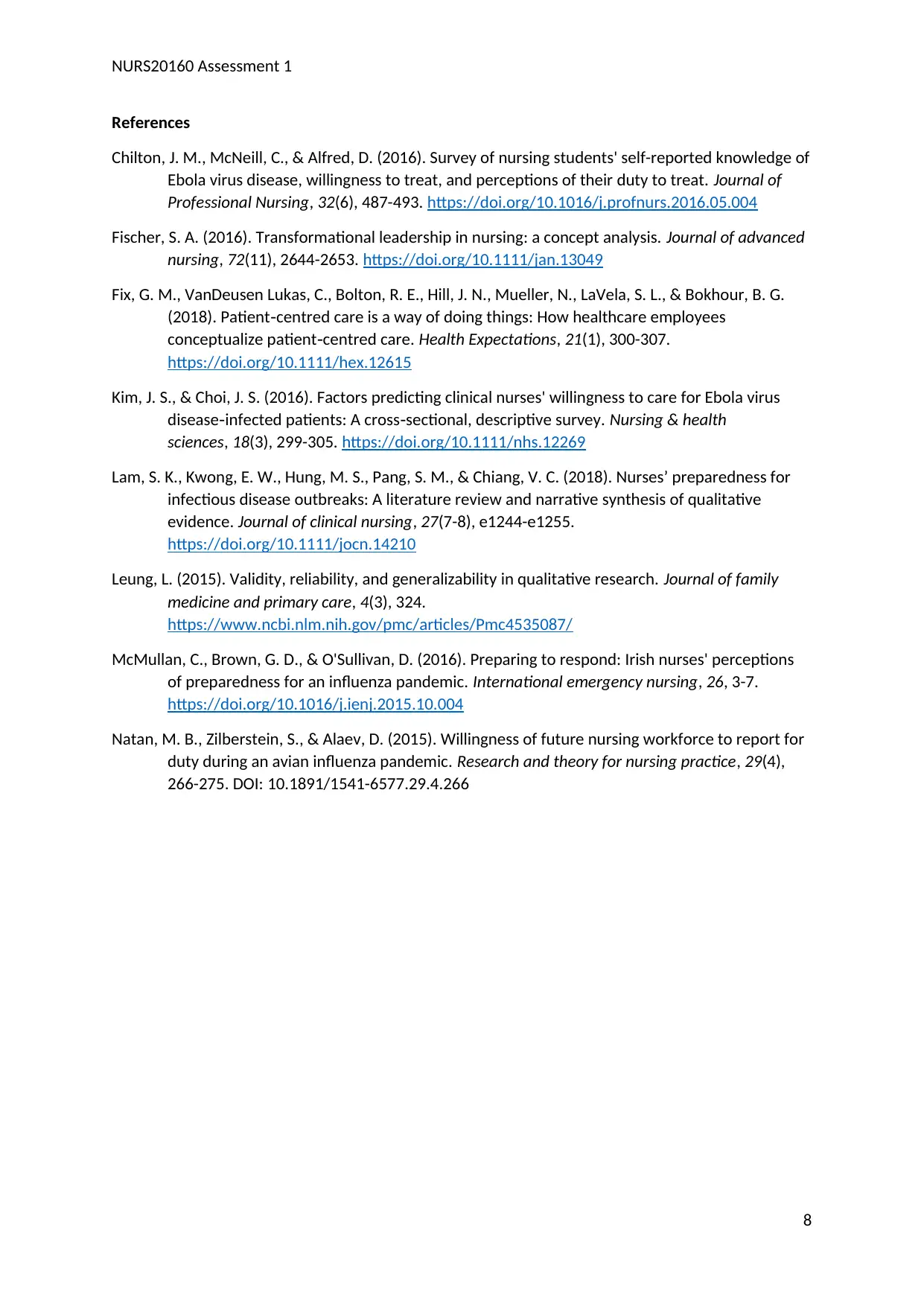
NURS20160 Assessment 1
References
Chilton, J. M., McNeill, C., & Alfred, D. (2016). Survey of nursing students' self-reported knowledge of
Ebola virus disease, willingness to treat, and perceptions of their duty to treat. Journal of
Professional Nursing, 32(6), 487-493. https://doi.org/10.1016/j.profnurs.2016.05.004
Fischer, S. A. (2016). Transformational leadership in nursing: a concept analysis. Journal of advanced
nursing, 72(11), 2644-2653. https://doi.org/10.1111/jan.13049
Fix, G. M., VanDeusen Lukas, C., Bolton, R. E., Hill, J. N., Mueller, N., LaVela, S. L., & Bokhour, B. G.
(2018). Patient centred care is a way of doing things: How healthcare employees‐
conceptualize patient centred care.‐ Health Expectations, 21(1), 300-307.
https://doi.org/10.1111/hex.12615
Kim, J. S., & Choi, J. S. (2016). Factors predicting clinical nurses' willingness to care for Ebola virus
disease infected patients: A cross sectional, descriptive survey.‐ ‐ Nursing & health
sciences, 18(3), 299-305. https://doi.org/10.1111/nhs.12269
Lam, S. K., Kwong, E. W., Hung, M. S., Pang, S. M., & Chiang, V. C. (2018). Nurses’ preparedness for
infectious disease outbreaks: A literature review and narrative synthesis of qualitative
evidence. Journal of clinical nursing, 27(7-8), e1244-e1255.
https://doi.org/10.1111/jocn.14210
Leung, L. (2015). Validity, reliability, and generalizability in qualitative research. Journal of family
medicine and primary care, 4(3), 324.
https://www.ncbi.nlm.nih.gov/pmc/articles/Pmc4535087/
McMullan, C., Brown, G. D., & O'Sullivan, D. (2016). Preparing to respond: Irish nurses' perceptions
of preparedness for an influenza pandemic. International emergency nursing, 26, 3-7.
https://doi.org/10.1016/j.ienj.2015.10.004
Natan, M. B., Zilberstein, S., & Alaev, D. (2015). Willingness of future nursing workforce to report for
duty during an avian influenza pandemic. Research and theory for nursing practice, 29(4),
266-275. DOI: 10.1891/1541-6577.29.4.266
8
References
Chilton, J. M., McNeill, C., & Alfred, D. (2016). Survey of nursing students' self-reported knowledge of
Ebola virus disease, willingness to treat, and perceptions of their duty to treat. Journal of
Professional Nursing, 32(6), 487-493. https://doi.org/10.1016/j.profnurs.2016.05.004
Fischer, S. A. (2016). Transformational leadership in nursing: a concept analysis. Journal of advanced
nursing, 72(11), 2644-2653. https://doi.org/10.1111/jan.13049
Fix, G. M., VanDeusen Lukas, C., Bolton, R. E., Hill, J. N., Mueller, N., LaVela, S. L., & Bokhour, B. G.
(2018). Patient centred care is a way of doing things: How healthcare employees‐
conceptualize patient centred care.‐ Health Expectations, 21(1), 300-307.
https://doi.org/10.1111/hex.12615
Kim, J. S., & Choi, J. S. (2016). Factors predicting clinical nurses' willingness to care for Ebola virus
disease infected patients: A cross sectional, descriptive survey.‐ ‐ Nursing & health
sciences, 18(3), 299-305. https://doi.org/10.1111/nhs.12269
Lam, S. K., Kwong, E. W., Hung, M. S., Pang, S. M., & Chiang, V. C. (2018). Nurses’ preparedness for
infectious disease outbreaks: A literature review and narrative synthesis of qualitative
evidence. Journal of clinical nursing, 27(7-8), e1244-e1255.
https://doi.org/10.1111/jocn.14210
Leung, L. (2015). Validity, reliability, and generalizability in qualitative research. Journal of family
medicine and primary care, 4(3), 324.
https://www.ncbi.nlm.nih.gov/pmc/articles/Pmc4535087/
McMullan, C., Brown, G. D., & O'Sullivan, D. (2016). Preparing to respond: Irish nurses' perceptions
of preparedness for an influenza pandemic. International emergency nursing, 26, 3-7.
https://doi.org/10.1016/j.ienj.2015.10.004
Natan, M. B., Zilberstein, S., & Alaev, D. (2015). Willingness of future nursing workforce to report for
duty during an avian influenza pandemic. Research and theory for nursing practice, 29(4),
266-275. DOI: 10.1891/1541-6577.29.4.266
8
1 out of 8
Related Documents
Your All-in-One AI-Powered Toolkit for Academic Success.
+13062052269
info@desklib.com
Available 24*7 on WhatsApp / Email
![[object Object]](/_next/static/media/star-bottom.7253800d.svg)
Unlock your academic potential
Copyright © 2020–2025 A2Z Services. All Rights Reserved. Developed and managed by ZUCOL.





